By Doreen Simonsen
Humanities and Fine Arts Librarian
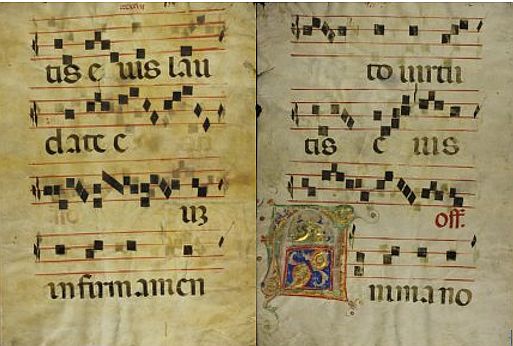
Somewhere in Europe in the 15th century, a choir sang an Alleluia followed by an Offertory on the Feast of the Holy Innocents on December 28th. A page from a book that contained parts of these songs was discovered last summer in the Vault of the Mark O. Hatfield Library. We do not know who donated this manuscript page to the library, but through the help of faculty members in the Music and Classical Studies Departments at Willamette University and elsewhere, we have been able to reveal its secrets and show how it relates to the holiday season.

Psalter
France, Paris, between 1495 and 1498
MS M.934 fol. 141r
Morgan Library and Museum
This large sheet of vellum (parchment prepared from animal skin) is 20 ⅞ inches high by 15 ⅔ inches wide and has neumatic (plainsong) notation on a four-line staff with texts in Latin. Chants are written in neumes, which are notes sung on a single syllable.
There is a large Illuminated initial in the lower left-hand corner of second page. (To see how this page and illumination was created, please watch this excellent video, Making Manuscripts, from the Getty Museum.) The reason for the large size of this page was that it was meant to be read by several members of a choir at one time. The expense of creating manuscript books meant that it would be more economical to create one large book for several people to use rather than several smaller books for each person in the choir to hold.
Here is an illustration from a Psalter (A book of Psalms) showing a group of clerics singing from a large book with musical notation, similar in size and format to our manuscript.
 Identifying the Texts:
Identifying the Texts:
Professors Robert Chenault and Ortwin Knorr of Willamette University’s Department of Classical Studies identified the texts found on these two pages.
This first page (or recto page) contains the following words and word fragments:
…tis eius; laudate eum in firmamen-
And the second page (or verso page) contains the rest of the phrase:
to virtutis eius.
These phrases combine to form the end of this Bible Verse:
Alleluia. Laudate Dominum in sanctis eius; laudate eum in firmamento virtutis eius.
 Psalm 150, Verse 1 (King James Version) Praise ye the Lord. Praise God in his sanctuary: praise him in the firmament of his power.
Psalm 150, Verse 1 (King James Version) Praise ye the Lord. Praise God in his sanctuary: praise him in the firmament of his power.
At the bottom of the second (verso) page, they identified the words: Anima no- which Dr. Richard Robbins (University of Minnesota-Duluth) identified as belonging to this verse:
Anima nostra sicut passer erepta est de laqueo venantium; laqueus contritus est, et nos liberati
sumus.
Psalm 123, Verse 7 (King James Version) Our soul is escaped as a bird out of the snare of the fowlers: the snare is broken, and we are escaped.
The two texts are separated by a red abbreviation of the word Offertory.
Identifying the Music
Professor Hector Aguëro of the Music Department at Willamette University shared images of our manuscript with his colleague Professor Richard Robbins, Director of Choral Activities at the University of Minnesota-Duluth and a scholar of choral music, especially Italian sacred music of the early Baroque.
Dr. Robbins identified our manuscript as possibly being part of a Gradual, which is a book containing chants used in the Catholic Mass throughout the year. Robbins identified the first text and melody as the end of an alleluia verse, specifically Laudate Deum (mode IV). The second melody is an offertory on the text Anima Nostra (mode II).
Both of these chants can be found in the Liber Usualis, a book of commonly used Gregorian chants in the Catholic tradition.
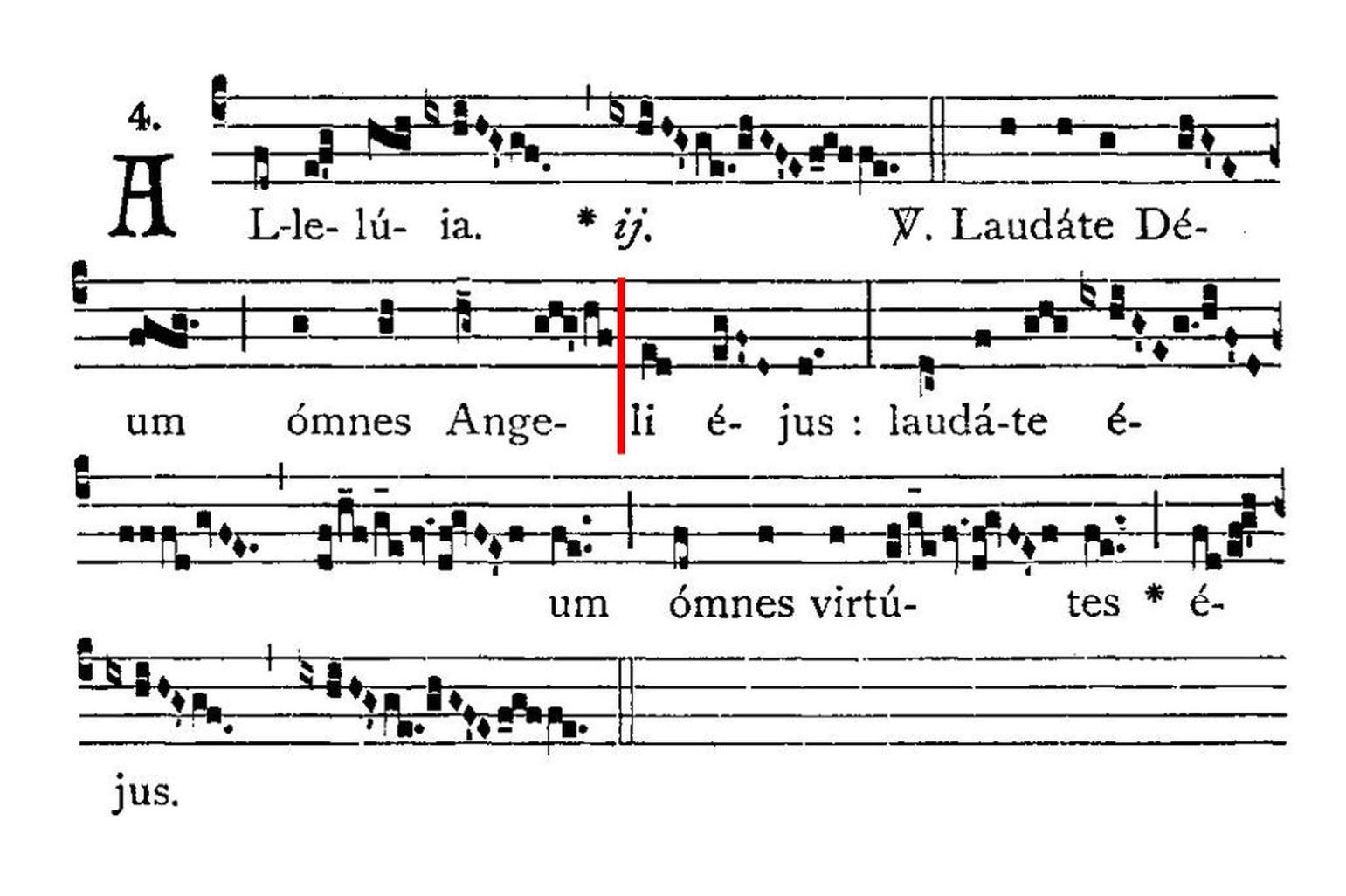
The notation on the library’s manuscript starts at the red line in the Alleluia above, and it ends at the red line in the Offertory Anima No|stra below.
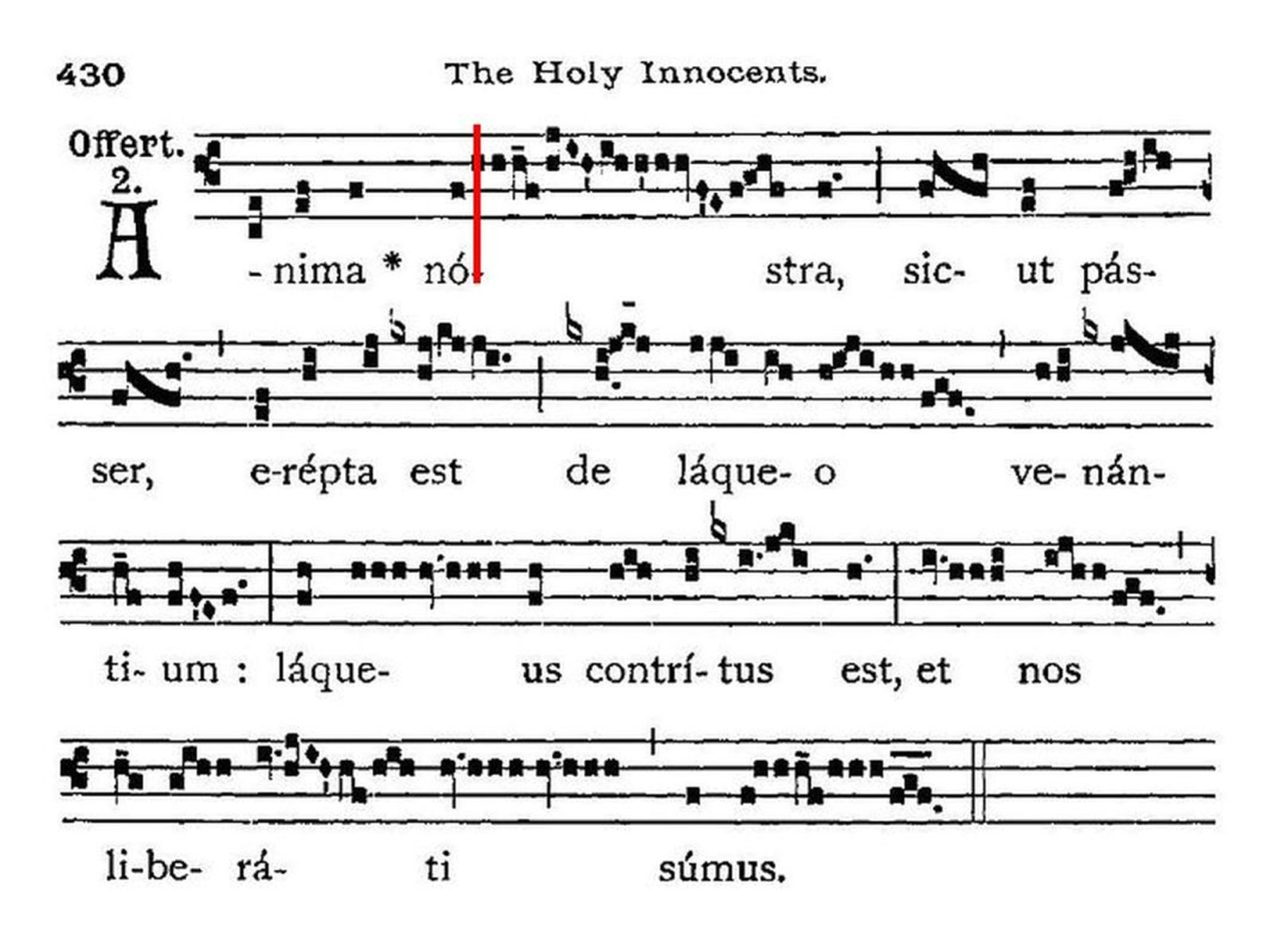
You can hear a performance and follow the texts of both chants here:
Alleluia, Laudate Deum
Offertory: Anima Nostra
The text of our missal differs from that of the Liber Usualis because of its early date. It was likely written in the 15th century, and, as Dr. Robbin explains, that means it was written before the Council of Trent (1545–63) codified the Catholic Mass and the order of the chants. There was a great deal of variety in Missals before the Council of Trent, so one cannot be sure when these melodies were used during the liturgical year. However, according to Dr. Robbins, these tunes match the tunes that appear in the Holy Innocents / Epiphanytide sections in post-Trent missals.
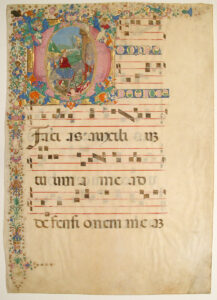
Dr. Robbins also pointed out that the illuminated letter A is ornate, which would have also been more appropriate for a Christmas use. The fancy illuminated letter A is probably also the reason we only have just one sheet from this gradual. These pages could contain ornate decorations and for this reason, they were frequently removed from graduals and treated as single artworks. Here you can see similar gradual pages from the Metropolitan Museum of Art. And this page shows the entry of Jesus into Jerusalem on Palm Sunday, all within the large initial D.
Teaching with a 15th Century Manuscript
The best thing about discovering this “new” manuscript in the vault was being able to share it with the students and faculty of Willamette University. In September 2019, as part of his Music History I course, Professor Aguëro had his Music History students transcribe the music written on the library’s Chant manuscript. Here you can see them displaying their work. It was such a delight to have students work with a manuscript from the library’s Rare Books Collection.
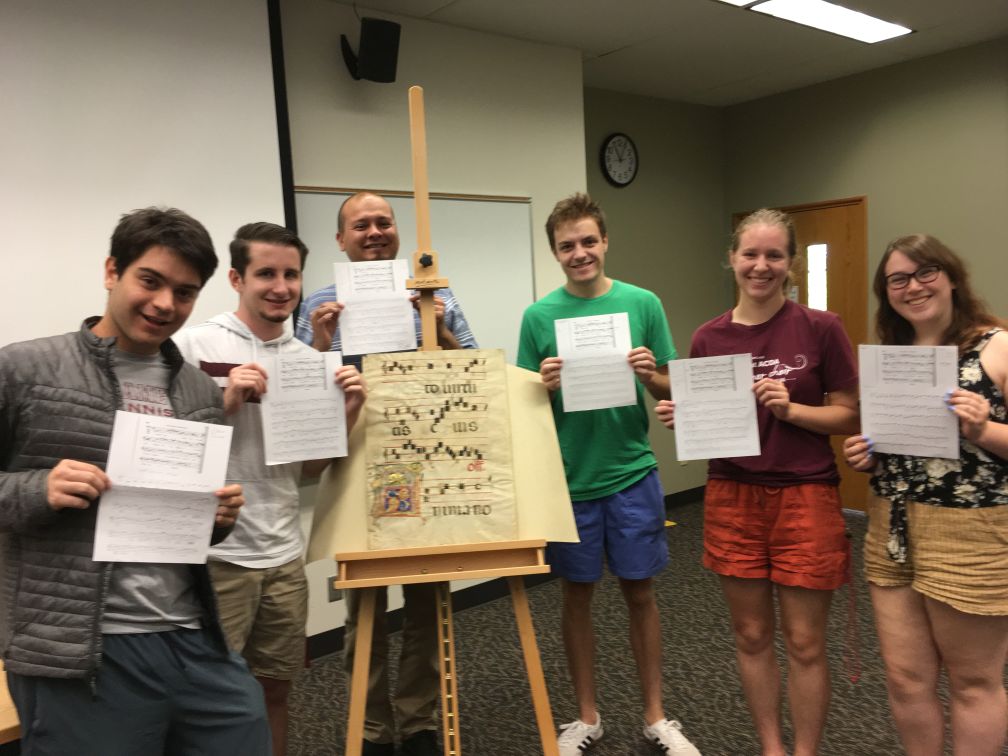
From left to right: Ethan Frank, Matt Elcombe, Professor Aguëro, Sam Strawbridge, Kate Grobey, and Sophie Gourlay
Acknowledgments
Many thanks to Professors Robert Chenault and Ortwin Knorr of the Department of Classical Studies and Professor Hector Aguëro of the Department of Music at Willamette University, and especially to Professor Richard Robbins, Director of Choral Activities at the University of Minnesota-Duluth. Their combined scholarship helped us explicate the text and illuminate the value and beauty of this seasonal manuscript.
Bibliography
Abbey of Solesmes. The Liber Usualis 1961. Internet Archive, http://archive.org/details/TheLiberUsualis1961. Accessed 27 Nov. 2019.
Anima Nostra Sicut Passer Erepta Est. YouTube, https://www.youtube.com/watch?v=2UrXb2QUSsI. Accessed 27 Nov. 2019.
“Bartolomeo Di Domenico Di Guido | Manuscript Leaf with Entry into Jerusalem on Palm Sunday in an Initial D, from a Gradual | Italian | The Met.” The Metropolitan Museum of Art, https://www.metmuseum.org/art/collection/search/469046. Accessed 27 Nov. 2019.
Chant Manuscript, ca. 15th Century. https://libmedia.willamette.edu/commons/item/id/163. Accessed 27 Nov. 2019.
Council of Trent. Sacrosancti et œcumenici Concillii Tridentini Pavlo III, Ivlio III, et Pio IV, PP. MM. celebrati canones et decreta. Apud Cornab Egmond et Socios, 1644.
“Council of Trent | Definition, Summary, Significance, Results, & Facts.” Encyclopedia Britannica, https://www.britannica.com/event/Council-of-Trent. Accessed 27 Nov. 2019.
Gregorian Chant Notation. http://www.lphrc.org/Chant. Accessed 27 Nov. 2019.
Laudate Deum – Gregorian Chant, Catholic Hymns. YouTube, https://www.youtube.com/watch?v=kaVnBFhiwqU. Accessed 27 Nov. 2019.
Making Manuscripts. YouTube, https://www.youtube.com/watch?v=nuNfdHNTv9o&feature=youtu.be. Accessed 27 Nov. 2019.
Psalter, MS M.934 Fol. 141r – Images from Medieval and Renaissance Manuscripts – The Morgan
Library & Museum. http://ica.themorgan.org/manuscript/page/120/77003. Accessed 27 Nov. 2019
Robbins, Richard. “Re: Newly discovered 15th c. Chant manuscript.” Received by Hector Aguero, 22 Aug. 2019.
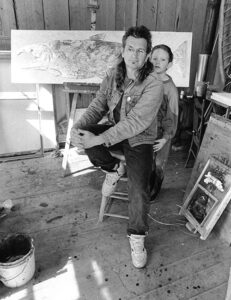 Bartow’s art career began with exhibitions at galleries in Newport, Oregon. In 1985 he was selected for a solo exhibition at Jamison/Thomas Gallery in Portland, Oregon. He exhibited at Jamison’s galleries in Portland and New York until Jamison’s death in 1995. Bartow was then represented by Charles Froelick of Froelick Gallery in Portland, Oregon. Bartow’s work can be found in museum collections throughout the United States including the Brooklyn Museum in Brooklyn, New York; the Peabody Essex Museum in Salem, Massachusetts; the Eiteljorg Museum of American Indians and Western Art in Indianapolis, Indiana; the National Museum of the American Indian in Washington, DC; the Hallie Ford Museum of Art at Willamette University in Salem, Oregon; the Heard Museum in Phoenix, Arizona; the Portland Art Museum in Portland, Oregon; and the Jordan Schnitzer Museum of Art at the University of Oregon. Bartow’s 35-year career as an artist was celebrated through the retrospective exhibition “Things You Know But Cannot Explain,” which traveled through various museums in the United States from 2015 to 2019.
Bartow’s art career began with exhibitions at galleries in Newport, Oregon. In 1985 he was selected for a solo exhibition at Jamison/Thomas Gallery in Portland, Oregon. He exhibited at Jamison’s galleries in Portland and New York until Jamison’s death in 1995. Bartow was then represented by Charles Froelick of Froelick Gallery in Portland, Oregon. Bartow’s work can be found in museum collections throughout the United States including the Brooklyn Museum in Brooklyn, New York; the Peabody Essex Museum in Salem, Massachusetts; the Eiteljorg Museum of American Indians and Western Art in Indianapolis, Indiana; the National Museum of the American Indian in Washington, DC; the Hallie Ford Museum of Art at Willamette University in Salem, Oregon; the Heard Museum in Phoenix, Arizona; the Portland Art Museum in Portland, Oregon; and the Jordan Schnitzer Museum of Art at the University of Oregon. Bartow’s 35-year career as an artist was celebrated through the retrospective exhibition “Things You Know But Cannot Explain,” which traveled through various museums in the United States from 2015 to 2019.

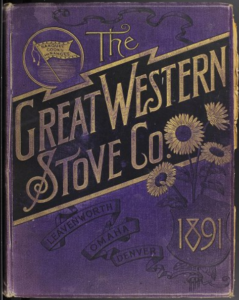
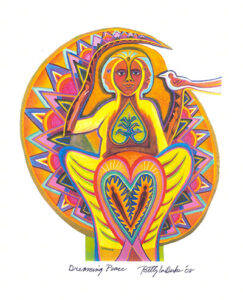 Additional materials for the Betty LaDuke papers have been processed and are open to researchers. This collection documents Betty LaDuke’s prolific career as a painter from 1950 to 2018. It includes her photography and sketchbooks from various international and domestic travels as well as materials that document her advocacy and representation of cultural traditions and women artists around the world. This collection also contains personal documents concerning her family and friends.
Additional materials for the Betty LaDuke papers have been processed and are open to researchers. This collection documents Betty LaDuke’s prolific career as a painter from 1950 to 2018. It includes her photography and sketchbooks from various international and domestic travels as well as materials that document her advocacy and representation of cultural traditions and women artists around the world. This collection also contains personal documents concerning her family and friends.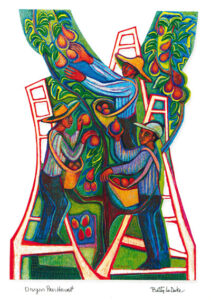


 Identifying the Texts:
Identifying the Texts: Psalm 150, Verse 1 (King James Version) Praise ye the Lord. Praise God in his sanctuary: praise him in the firmament of his power.
Psalm 150, Verse 1 (King James Version) Praise ye the Lord. Praise God in his sanctuary: praise him in the firmament of his power.



 Holiday parties are a fantastic way to celebrate this chilly season – and an invitation to a Tom Cramer Christmas party is a coveted item! Tom Cramer, a nationally known Oregon artist, is famous not only for his beautiful paintings and wood carvings but also for his epic parties. The
Holiday parties are a fantastic way to celebrate this chilly season – and an invitation to a Tom Cramer Christmas party is a coveted item! Tom Cramer, a nationally known Oregon artist, is famous not only for his beautiful paintings and wood carvings but also for his epic parties. The 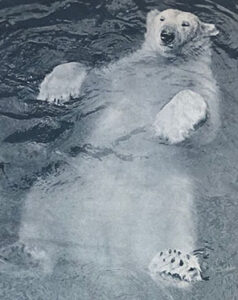 Does the arrival of December have you yearning for snow? Or perhaps you’re looking for some winter fashion inspiration? The Chuck Williams Collection, which will be open for research in early 2020, has you covered on both fronts. Williams’ extensive research materials on national parks and environmental issues offer a wealth of images and information to get you through the winter months.
Does the arrival of December have you yearning for snow? Or perhaps you’re looking for some winter fashion inspiration? The Chuck Williams Collection, which will be open for research in early 2020, has you covered on both fronts. Williams’ extensive research materials on national parks and environmental issues offer a wealth of images and information to get you through the winter months.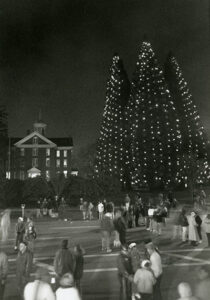 While the beloved Star Trees on Willamette’s campus brings joy to students, staff, faculty, and Salem citizens all year long, during the holiday season they seem to shine even brighter — both literally and figuratively. Planted in 1942 to commemorate Willamette’s centennial year, the Star Trees (five Sequoiadendron giganteums) twinkle during the month of December when they are strung with lights. This photograph from December 7, 1997, captures the Start Tree Lighting Ceremony festivities. This year the Star Tree Lighting & Holiday Celebration ceremony takes place on Wednesday, December 4th. Be sure to join the fun!
While the beloved Star Trees on Willamette’s campus brings joy to students, staff, faculty, and Salem citizens all year long, during the holiday season they seem to shine even brighter — both literally and figuratively. Planted in 1942 to commemorate Willamette’s centennial year, the Star Trees (five Sequoiadendron giganteums) twinkle during the month of December when they are strung with lights. This photograph from December 7, 1997, captures the Start Tree Lighting Ceremony festivities. This year the Star Tree Lighting & Holiday Celebration ceremony takes place on Wednesday, December 4th. Be sure to join the fun!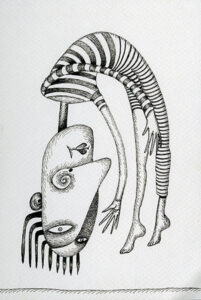 Collections of artists’ papers from the Pacific Northwest Artists Archive (
Collections of artists’ papers from the Pacific Northwest Artists Archive ( The Willamette University Archives and Special Collections is excited to share the PNAA digitization efforts with all library patrons and researchers. Throughout the fall and spring semesters, students will continue to digitize selected materials from the eight remaining PNAA collections. Don’t forget to check the Archives Blog for updates on our PNAA digitization project!
The Willamette University Archives and Special Collections is excited to share the PNAA digitization efforts with all library patrons and researchers. Throughout the fall and spring semesters, students will continue to digitize selected materials from the eight remaining PNAA collections. Don’t forget to check the Archives Blog for updates on our PNAA digitization project! The WU Archives and Special Collections collects, preserves, and makes available WU records of enduring value and primary source materials focusing on the Pacific Northwest. We have four main collections
The WU Archives and Special Collections collects, preserves, and makes available WU records of enduring value and primary source materials focusing on the Pacific Northwest. We have four main collections 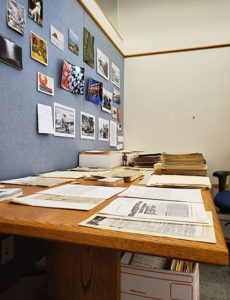 Rosie Yanosko is the Processing Archivist for the Chuck Williams Collections. Williams was an environmental activist and professional photographer who was of Cascade Chinook descent and a member of the Grand Ronde Tribe. His activist papers are housed here in the WU Archives, while his photographs are housed at the Oregon State University Special Collections and Archives Research Center. During her 12-month tenure, which is funded through the
Rosie Yanosko is the Processing Archivist for the Chuck Williams Collections. Williams was an environmental activist and professional photographer who was of Cascade Chinook descent and a member of the Grand Ronde Tribe. His activist papers are housed here in the WU Archives, while his photographs are housed at the Oregon State University Special Collections and Archives Research Center. During her 12-month tenure, which is funded through the 
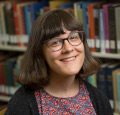
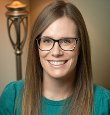
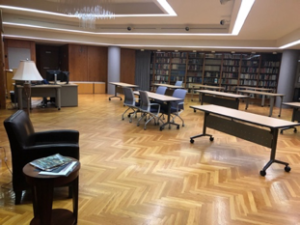
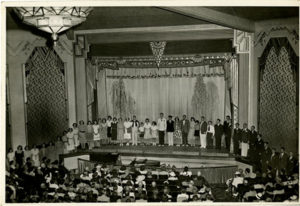 Estella Jean Douglas was born in Salem, Oregon on January 21, 1927. At age eleven, Douglas was inspired by what she described as “a flood of creative energy” to begin her lifelong calling to be an artist. In 1944 Douglas planned to enter a five-year degree program offered by Reed College with the Portland Art Museum School, but instead joined the Moral Re-Armament (MRA) program. Douglas participated as a full time volunteer in MRA from 1945 to 1957, during which she lived at MRA’s two main headquarters in Los Angeles and Mackinac Island, Michigan. She also lived in London, England and Paris and Caux, France while in the program. Douglas described her experience with MRA as a “multi-cultural learning experience” in which her “global view of life in the world and the nature of humanness took form.” Both during and after her time with MRA, Douglas wrote many personal reflections and letters pertaining to her experience as a participant in MRA and her subsequent reflections on morality, religion, and human nature.
Estella Jean Douglas was born in Salem, Oregon on January 21, 1927. At age eleven, Douglas was inspired by what she described as “a flood of creative energy” to begin her lifelong calling to be an artist. In 1944 Douglas planned to enter a five-year degree program offered by Reed College with the Portland Art Museum School, but instead joined the Moral Re-Armament (MRA) program. Douglas participated as a full time volunteer in MRA from 1945 to 1957, during which she lived at MRA’s two main headquarters in Los Angeles and Mackinac Island, Michigan. She also lived in London, England and Paris and Caux, France while in the program. Douglas described her experience with MRA as a “multi-cultural learning experience” in which her “global view of life in the world and the nature of humanness took form.” Both during and after her time with MRA, Douglas wrote many personal reflections and letters pertaining to her experience as a participant in MRA and her subsequent reflections on morality, religion, and human nature. Collections of artists’ papers from the Pacific Northwest Artists Archive (PNAA) are currently being processed thanks to the National Historical Publications and Records Commission
Collections of artists’ papers from the Pacific Northwest Artists Archive (PNAA) are currently being processed thanks to the National Historical Publications and Records Commission 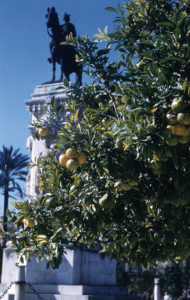 Madolyn is currently digitizing material from the
Madolyn is currently digitizing material from the